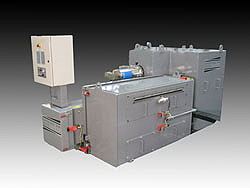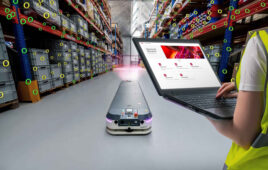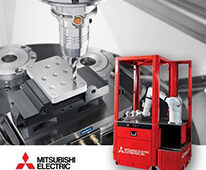Exporting offers a huge upside potential, but many small companies
still find that many challenges arise when they first stretch beyond
national borders. When PCT Engineered Systems redesigned a product and
targeted Europe, technical issues, certification and cultural
understanding were among the challenges that arose.
During its first 20 years, PCT
rarely sold outside the U.S. But an acquisition in 2003 set the stage
for an expansion that began last year. That’s when PCT completed a
targeted redesign of the system it acquired and improved substantially
its competitiveness in the printing press market.
That
product, BroadBeam, uses electron beam curing to dry inks much faster
than conventional gas-fired drying ovens. The system also significantly
reduces energy consumption, eliminating the heating expense and
pollution of gas ovens.

Another benefit of the redesign is a reduction in floor space
requirements. The BroadBeam system is only 7 feet long, far shorter
than the 20- to 100-foot systems that use large fans to blow hot air
over the printed material. Though it’s smaller, the BroadBeam system
still allows lines to run in excess of 1,000 feet per minute.
The new system is used primarily in producing food packaging,
particularly for paperboard cartons that contain milk or juice. The
system is also used to cure ink on flexible packaging materials such as
bags. A majority of the companies that make the printing presses for
this market are headquartered in Europe, while their customers are
scattered around the globe. Both can add the BroadBeam technology to
their equipment, so PCT has a huge overseas market potential.
“Our little company in Iowa is now knocking on doors all around the
world,” says Karl Swanson, sales and marketing manager at PCT. While
Europe is a central focus, he notes that the company’s marketing
efforts are truly global, since food packaging is produced everywhere.
The system provider based in Davenport, Iowa, discovered many new
issues when it started augmenting its domestic marketing efforts. They
had to use technology that is popular in each region so it would be
simpler for customers to integrate the curing system.
One technology that helps greatly in Europe is Profibus. The field
bus is a standard on BroadBeam systems, which helps it mesh easily with
the many European systems that use the well-known standard. That
connectivity makes it simpler to integrate the curing system with the
rest of the line.
PCT is also adopting control technologies that are popular in Europe
and other targeted regions. “Our products have to be compatible
globally, meshing with controls that are being installed on the
printing presses,” Swanson says.

Often,
that means adopting programmable logic controllers made by Siemens
Industry. Partnering with Siemens provides global compatibility while
also making it simpler for PCT to leverage the global reach of a
well-established company that has personnel in more than 190 countries.
When PCT is developing versions for certain countries, they often
seek advice from Siemens’ support staff. “They help us make sure we get
the right model numbers for different products, making sure we properly
address the local requirements for the country,” says Pat Ward,
BroadBeam product manager at PCT Engineered Systems. ”We need to be
sure that the component ratings are suitable for our customer’s
location.”
Using devices that have already been proven makes the certification
process much simpler. When PCT is assembling their CE mark
certification file, they can simply check off the elements that they
know meet compliance requirements. “The more components that have
already been identified as meeting requirements, the easier it is to go
through the certification process,” Ward says.
Though these technical questions are an important issue for PCT,
they aren’t an enormous challenge for the Siemens technical staff.
That’s partially because the BroadBeam system doesn’t require a complex
control system.
“Our application is pretty basic for Siemens. It’s basically a PLC
running analog and digital I/O,” Ward says. He noted one of the
benefits of using basic PLCs and other common components is that spare
parts are readily available.

Another
benefit of having a large partner with global offices is the
availability of replacement parts. When a system stops working, PCT
sometimes sends its technicians out to the site to make repairs. Other
times, technicians in Iowa can use Internet links to diagnose problems,
then tell their customers which parts need to be replaced.
Either way, it’s always helpful to know that shutdowns won’t be
extended because spares weren’t readily available. “The fact that we’ve
got a strong partner means that we can get parts anywhere in the
world,” Ward says.
Technical issues are important, but many other issues arise when
marketers travel to new countries. Swanson also turns to his larger
partner when it’s time to get a bit of help with local customs. Siemens
staffers can help explain some of the differences in their region.
“The more business we do abroad, the more we realize how critical
the cultural differences are,” Swanson says. “The way people interpret
a comment in Greece, Australia or China are very different.”
PCT is expanding its reach by teaming up with additional marketing
and sales personnel who know the markets and the regions. Having this
local presence is a necessity to establish a presence and help build
confidence in the brand name, Swanson says.“Initially, we identified
sales reps that could work with us, some were reps of companies that
make equipment our systems are used with. Then other reps came to us
when we exhibited at focused trade shows,” he explains.
PCT has seen solid success in global markets and has plans to expand
its international sales. One key in its efforts will be to continue
working closely with companies like Siemens that can provide support as
well as technology.
::Design World::
Filed Under: Factory automation, CONNECTIVITY • fieldbuses • networks, Packaging, PLCs + PACs





Tell Us What You Think!